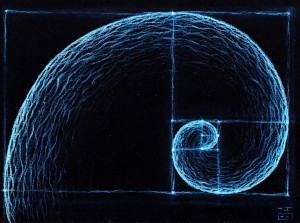As you look at previous colour systems in history, you can see that most of the colour systems are based on a geometrical shape or a figure. The reason behind that is having a geometrical shape as a base helps you to locate colours in a logical way because of their symetrycal shapes and perfectness.
Many people used spheres,cubes and pyramids for many diffrent colour systems, But nobody used a special shape as golden ratio. What makes golden ratio this special ?
The golden ratio is a mathematical principle that you might also hear referred to as the golden mean, the golden section, the golden spiral, divine proportion, or Phi. Phi, a bit like Pi, is an irrational number. It is valued at approximately 1.618. As a ratio, it would be expressed as 1:1.618. A rectangle that conforms to the golden ratio would have shorter sides equivalent to 1 and longer sides equivalent to 1.618.
The question is, then, why (or indeed why not) do we find the proportion delivered by an obscure mathematical theory aesthetically appealing?
For a start, the golden ratio tends to crop up with surprising frequency within the natural world: from leaf and seed arrangements to aluminium alloy crystal structures. And it would seem that much of the mysticism surrounding the aesthetic properties of the golden ratio are divined from its natural occurrences.
Even if you do find the golden ratio attractive, finding an explanation for its appeal, beyond the vague assertion that its prevalence in nature gives it some kind of mystical property, is hard to find. I’m inclined to suggest that its mythic qualities enhance its attraction. If something is supposed to represent aesthetic perfection and no other reason supports the theory other than its repeated appearance in nature, it becomes a self-fulfilling prophecy.

However, Prof Adrian Bejan, of Duke’s Pratt School of Engineering, has posited a theory pertaining to our preference for the golden ratio that is rooted in his research around the idea of ‘flow,’ and how nature’s designs evolve to enable ever-increasing efficiency of movement. In the case of the golden ratio, it stems from an animal’s need to scan the horizon and quickly apprise it of information. Supposedly the most efficient form for doing this is a rectangle that is approximately one-and-half times as wide as it is tall. This amounts, roughly, to the golden ratio. According to Prof. Bejan: ‘Animal vision should be configured in a way that seeing and scanning should be the fastest and the easiest. And when the proportions allow this to be done, it should be a source of pleasure because of its past evolutionary associations with finding food or a mate.’
The Golden ratio color system is unlimited and can be expanded as required. But in any case, at the beginning of the system there is White and at the end there is black. Between black and White you can see every colour in rainbow orderly located on top of the meridians. There is a fiction in the Golden ratio color system. Each color provides a transition between tones that causes effect on the next color.
